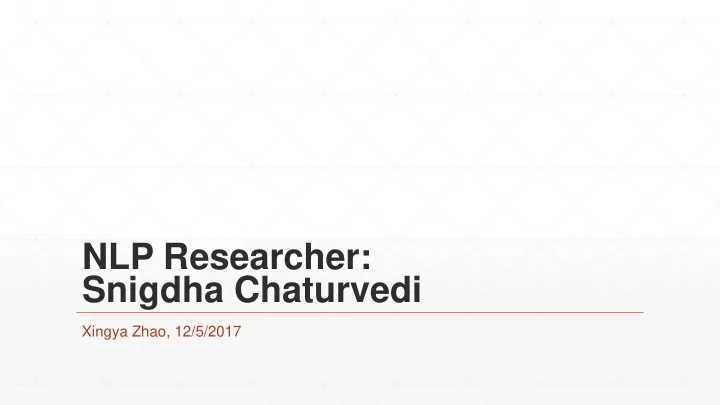

NLP Researcher: Snigdha Chaturvedi Xingya Zhao, 12/5/2017
Contents ▪ About Snigdha Chaturvedi ▪ Education and working experience ▪ Research Interest ▪ Dynamic Relationships Between Literary Characters ▪ Problem definition ▪ Dr. Chaturvedi’s works
Snigdha Chaturvedi – Education ▪ A postdoctoral researcher in Dan Roth's group at the University of Pennsylvania ▪ Education ▪ Ph.D., University of Maryland, College Park 2011 - 2016 ▪ Thesis: Structured Approaches to Exploring Inter-personal Relationships in Natural Language Text ▪ Advisor: Dr. Hal Daumé III ▪ B.Tech., Indian Institute of Technology (IIT) 2005 - 2009
Snigdha Chaturvedi – Work Experience ▪ Work Experience (selected) ▪ Postdoctoral Researcher, UPenn 2017 – Present ▪ Advisor: Dr. Dan Roth ▪ Postdoctoral Researcher, UIUC 2016 - 2017 ▪ Advisor: Dr. Dan Roth ▪ Blue Scholar, IBM Research India 2009 - 2011 ▪ Her personal homepage: https://sites.google.com/site/snigdhac/
Snigdha Chaturvedi – Research Interest ▪ Natural language understanding, machine learning, text mining ▪ S Chaturvedi , H Peng, D Roth, ‘Story Comprehension for Predicting What Happens Next’, Conference on Empirical Methods in Natural Language Processing (EMNLP) 2017 ▪ H Peng, S Chaturvedi , D Roth, ‘A Joint Model for Semantic Sequences: Frames, Entities, Sentiments ’, The SIGNLL Conference on Computational Natural Language Learning ( CoNLL), 2017 ▪ S Chaturvedi , D Goldwasser and H Daum ́e III, ‘Ask, and shall you receive?: Understanding Desire Fulfillment in Natural Language Text’, AAAI Conference on Artificial Intelligence (AAAI), 2016
Snigdha Chaturvedi – Research Interest ▪ Understanding dynamic relationships between literary characters ▪ S Chaturvedi , M Iyyer, H Daum ́e III, ‘Unsupervised Learning of Evolving Relationships Be- tween Literary Characters’, AAAI Conference on Artificial Intelligence (AAAI), 2017 ▪ M Iyyer, A Guha, S Chaturvedi , J Boyd-Graber, H Daum ́e III, ‘Feuding Families and Former Friends: Unsupervised Learning for Dynamic Fictional Relationships’, Conference of the North American Chapter of the Association for Computational Linguistics: Human Language Technologies (NAACL), 2016 (Best Paper Award) ▪ S Chaturvedi , S Srivastava, H Daum ́e III and C Dyer, ‘Modeling Evolving Relationships Between Characters in Literary Novels’, AAAI Conference on Artificial Intelligence (AAAI), 2016
Dynamic Relationships Between Literary Characters
Modeling Evolving Relationships Between Characters in Literary Novels ▪ Goal: learning relationship binary-variable (cooperative/non-cooperative) sequences in given narrative texts ▪ Esteban and Ferula’s relationship: <cooperative, non-cooperative> ▪ Contribution and highlights ▪ Formulate the novel problem of relationship modeling in narrative text as a structured prediction task ▪ Propose rich linguistic features that incorporate semantic and world knowledge ▪ Present a semi-supervised framework and empirically demonstrate that it outperforms competitive baselines
Modeling Evolving Relationships Between Characters in Literary Novels ▪ J48: decision tree, LR: logistic regression
Modeling Evolving Relationships Between Characters in Literary Novels
Feuding Families and Former Friends: Unsupervised Learning for Dynamic Fictional Relationships ▪ Goal: Unsupervised relationship modeling. The model jointly learns a set of relationship descriptors as well as relationship trajectories for pairs of literary characters. ▪ Esteban and Ferula’s relationship: <move-in, rivalry, madness, kick-out, curse> ▪ Contribution and highlights ▪ Propose the relationship modeling network (RMN), a novel variant of a deep recurrent auto encoder that incorporates dictionary learning to learn relationship descriptors
Feuding Families and Former Friends: Unsupervised Learning for Dynamic Fictional Relationships
Modeling Evolving Relationships Between Characters in Literary Novels ▪ Goal: unsupervised modeling of inter-character relationships from unstructured text ▪ Contribution and highlights ▪ Present three models based on rich sets of linguistic features that capture various cues about relationships ▪ Hidden Markov Model with Gaussian Emissions (GHMM), Penalized GHMM, and Globally Aware GHMM ▪ Outperforms the RMN ▪ Better generated relationship: the subjects chose Globally Avare GHMM over RMN for 66:2% of the character pairs ▪ Better representation: 66:0% of the states learned by Globally Aware GHMM to be representing an inter-personal relationship, 50:0% for RMN’s states
Recommend
More recommend